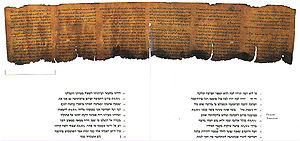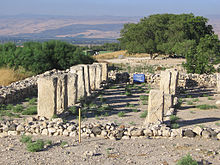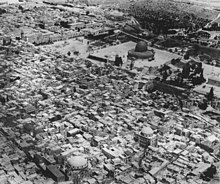以色列考古学


以色列考古学是研究以色列从史前到近三千年来有文字记录历史的考古学研究。在古代,以色列这片土地是中东两大政治文化中心,美索不达米亚文明和古埃及文明,的地理桥梁。 尽管以色列是三大宗教圣地,严谨的考古学研究自15世纪才开始起步。[1] 第一部关于以色列考古的主要著作是1709年出版的Adrian Reland'写的 Palestina ex monumentis veteribus。 Edward Robinson,1838年考察过圣地的美国神学家,发表了第一部地形学研究。1850年法国人 Louis Felicien de Saucy,开始第一次“现代”发掘。
在讨论1980年代当时以色列考古学时,以色列考古学家大卫·乌西什金评论说“以色列考古学”这个名称不再代表单一的研究路径,它的范围已经涵盖多种多样的考古学派、学科和方法。[2]
以色列考古分期
[编辑]新石器时代
[编辑]
铜器时代/ 迦南人时期
[编辑]
铜器时代(3300-1200BCE)指的是铜器使用的时期。 许多作者将黎凡特铜器时代之后的历史和圣经中的事件联系起来。铜器时代和铁器时代有时一起被称为 "圣经时期".[3] 铜器时代的分期如下:
- 铜器时代早期 I (EB I) 3330–3050 BCE
- 铜器时代早期 II–III (EB II–III) 3050–2300 BCE
- 铜器时代早期 IV/ 铜器时代中期 I (EB IV/MB I) 2300–2000 BCE
- 铜器时代中期 IIA (MB IIA) 2000–1750 BCE
- 铜器时代中期 IIB (MB IIB) 1800–1550 BCE
- 铜器时代晚期 I–II (LB I–II) 1550–1200 BCE
铜器时代晚期的特征是有许多反复被埃及统治的城邦国家,直到 1207年 法老麦伦普塔 的最后一次入侵。 阿马尔奈文书 反应铜器时代晚期黎凡特的城邦国国王们和他们的埃及宗主通信的某段历史。
铁器时代/以色列时期
[编辑]
黎凡特地区的铁器时代大约从铁器开始使用的公元前1200年开始。铁器时代也被称为以色列时期。这一时期的特征是出现许多城镇聚落和一种新型地方文明。丰富多样的考古发现证明当时有很强的国际联系和商业往来。发现的许多文字表明不仅是祭祀,古代普通以色列人很多具备书写能力,这是古代世界的独特现象。
在这一时期,考古证据和圣经文本证据都变得更加丰富,有更多的著作试图将两者联系起来。铁器时代分期如下:
- 铁器时代 I (IA I) 1200–1000 BCE
- 铁器时代 IIA (IA IIA) 1000–925 BCE
- 铁器时代 IIB-C (IA IIB-C) 925–586 BCE
- 铁器时代 III 586–539 BCE (新巴比伦帝国时期)
传统观点,以奥布莱特和怀特为代表,忠实的接受圣经事件的历史性,但是这被“圣经疑古派”如 Niels Peter Lemche, Thomas L. Thompson 和Philip R. Davies质疑。伊斯雷尔·芬克尔斯坦[4] 认为大卫和所罗门帝国(以色列统一王国)根本不存在,犹大国直到公元前8世纪才开始发展为成熟国家。芬克斯坦 接受大卫王和所罗门历史上存在,但怀疑圣经中描述的他们的年表、重要性和影响力。[5] 不需认为圣经中的所有事件都是准确历史记载,圣经中的一些非超自然事件看起来和一些文物和考古发现相符。像但丘石碑和米沙石碑可以溯源到非希伯来文化。
波斯时期
[编辑]
希腊化时期
[编辑]
罗马时期
[编辑]

拜占庭时期
[编辑]拜占庭时期(330-638CE),从罗马帝国基督教化至穆斯林征服巴勒斯坦/以色列地区
拜占庭时期的主要考古发现:
著名考古遗址
[编辑]亚实基伦
[编辑]Beit Alfa
[编辑]
Carmel Caves
[编辑]Mamshit
[编辑]
阿克(阿卡)古城
[编辑]
阿卡古城在2001年被联合国教科文组织列为世界文化遗产,[10]阿卡古城自1990年代以来一直有很多考古发掘项目。主要的发现是通往一个13世纪的圣殿骑士团堡垒的地下通道。十字军时期的阿卡遗迹,可追溯到1104年至1291年,保存完好,并在当前阿卡的地表和地下展示。
Tel Rehov
[编辑]别是巴遗址
[编辑]A UNESCO World Heritage site since 2005, Tel Be'er Sheva is an archaeological site in southern Israel, believed to be the remains of the biblical town of Be'er Sheva. Archaeological finds indicate that the site was inhabited from the Chalcolithic period, around 4000 BCE,[11][12]to the 16th century CE. This was probably due to the abundance of underground water, as evidenced by the numerous wells in the area. Excavated by Yohanan Aharoni and Ze'ev Herzog of Tel Aviv University, the settlement itself is dated to the early Israelite period.[13]Probably populated in the 12th century BCE, the first fortified settlement dates to 1000 BCE.[14]The city was likely destroyed by Sennacherib in 700 BCE, and after a habitation hiatus of three hundred years, there is evidence of remains from the Persian, Hellenistic, Roman and Early Arab periods.[14]Major finds include an elaborate water system and a huge cistern[15]carved out of the rock beneath the town, and a large horned altar which was reconstructed using several well-dressed stones found in secondary use in the walls of a later building. The altar attests to the existence of a temple or cult center in the city which was probably dismantled during the reforms of King Hezekiah.[16]
米吉多遗址
[编辑]2005年,米吉利多遗址被列为联合国教科文组织世界文化遗产,米吉多包括二十六个分层的古城的废墟在一个战略位置通过Carmel里奇的顶端,俯瞰Jezreel从西部谷。 米吉多已经挖掘了三次。第一次挖掘在1903年和1905年之间进行,第二次远征在1925年进行。在这些挖掘期间,发现有二十层的居住,并且许多遗骸被保存在耶路撒冷的洛克菲勒博物馆和芝加哥大学东方研究所。伊加尔·雅丁在20世纪60年代进行了几次小型挖掘。自1994年以来,米吉多一直是由伊斯雷尔·芬克尔斯坦和乌西什金领导的特拉维夫大学米吉多探险队与一个国际大学联合会进行的半年挖掘运动的主题。在1927年和1934年之间进行的挖掘的主要发现是米吉多马厩- 两个三边形结构,尺寸为21米×11米,据信是古代的马厩能够容纳近500匹马。
Beit She'arim
[编辑]迦特
[编辑]
基色
[编辑]马萨达遗址
[编辑]
Tel Arad
[编辑]但遗址(Tel Dan)
[编辑]

Tzippori
[编辑]Gesher Bnot Ya'akov
[编辑]Ain Mallaha
[编辑]考古研究机构
[编辑]奥斯曼帝国时期的最后一百年(19世纪), 巴勒斯坦地区活跃的西方考古学家多数是基督徒, 受欧洲强国和教会支持。 随着奥斯曼帝国的统治被英国取代,考古学的政治性和宗教性减弱,历史性和科学性变得更强。一战和英国在巴勒斯坦的统治确定后,考古研究机构越来越多的集中在耶路撒冷.[17]:135–136
在1913年至1914年,Yishuv的知识精英成立了the Socity for the Reclamation of Antiquities。其创始人之一是Avraham Yaakov Brawer,David Yellin和Aharon Meir Mazie。该协会于1920年改名为犹太巴勒斯坦探索协会,后来改名为以色列探险协会。 耶路撒冷的英国考古学院在1921年开始运作,巴勒斯坦探矿基金会的斯图尔特·马卡利斯特和邓肯·麦肯齐先生呼吁英国政府建立一个当地文物当局。 Macalister和Mackenzie表示关注由于战斗在整个土地上战斗给考古遗址带来的危险。麦肯齐对警察考古遗址和偷窃物品也警惕 In 1913–1914 the Society for the Reclamation of Antiquities was established by the Yishuv's intellectual elite. Among its founder were Avraham Yaakov Brawer, David Yellin and Aharon Meir Mazie. The Society changed its name to the Jewish Palestine Exploration Society in 1920 and later to the Israel Exploration Society.[18][19] 耶路撒冷希伯来大学考古研究所成立于1926年。1934年希伯来大学开设了考古学系,被誉为“以色列考古学的发源地”[20] 特拉维夫大学考古研究所成立于1969.[21]
现代以色列国在1948年成立后, the British Mandatory Department of Antiquities, 设立在洛克菲勒考古博物馆(Rockefeller Museum)的, 成为以色列文物部. 1990年,以色列国家文物部成为以色列文物局( Israel Antiquities Authority), 一个自治的政府机构,负责所有国家的文物,并授权挖掘、保存、保护和管理文物.[22][23][24]
著名以色列考古学家
[编辑]- Eleazar Sukenik (1889–1953)
- Benjamin Mazar (1906–1995), a founding father of Israeli archaeology[25]
- Yigael Yadin (1917–1984)
- Amir Drori (1937–2005), founder of the Israel Antiquities Authority in 1990
- 伊斯雷爾·芬克爾斯坦
考古新技术
[编辑]Israeli archaeologists have developed a method of detecting objects buried dozens of meters underground using a combination of seven technologies, among them echomagnetic soundings, radio transmissions and temperature measurements, able to distinguish between relevant and irrelevant objects such as pipes in the ground.[26]
考古学政治化
[编辑]更多信息: Politics of archaeology in Israel and Palestine
Archaeological research and preservation efforts have been exploited by both Palestinians and Israelis for partisan ends.[27]Rather than attempting to understand "the natural process of demolition, eradication, rebuilding, evasion, and ideological reinterpretation that has permitted ancient rulers and modern groups to claim exclusive possession," archaeologists have instead become active participants in the battle over partisan memory, with the result that archaeology, a seemingly objective science, has exacerbated the ongoing nationalist dispute. Silberman concludes: "The digging continues. Claims and counterclaims about exclusive historical 'ownership' weave together the random acts of violence of bifurcated collective memory." Adam and Moodley conclude their investigation into this issue by writing that, "Both sides remain prisoners of their mythologized past."[27]
As an example of this process, an archaeological tunnel running the length of the western side of the Temple Mount, as it is known to Jews, or the Haram al-Sharif, as it is known to Muslims, became a serious point of contestation in 1996. The tunnel had been in place for about a dozen years, but open conflict broke out after the government of Benjamin Netanyahu decided to open a new entrance to the tunnel from the Via Dolorosa in the Muslim quarter of the Old City. Palestinians and the Islamic Waqf authorities were outraged that the decision was taken without prior consultation. They claimed that the work threatened the foundations of the compound and those of houses in the Muslim quarter and that it was actually aimed at tunnelling under the holy compound complex to find remains of Solomon's Temple, similar to previous accusations in the 1980s. As a result of the rumor, Arabs rioted in Jerusalem and then spread to the West Bank, leading to the deaths of 86 Palestinians and 15 Israeli soldiers.[28]
对考古遗址的破坏
[编辑]
1948–1967年,约旦当局和军队参与了对耶路撒冷老城犹太区的“精心策划的摧毁”。 [29] 在以色列驻联合国代表Yosef Tekoa写给联合国的信中,他抗议约旦“恶意毁坏、亵渎和侵犯”的政策 ,老城内除了一处会堂外,所有犹太会堂被炸毁或被作为马厩。[30] 通往橄榄山犹太人墓地的道路被切断,上万块犹太人墓碑,一些追溯到公元前一世纪,被毁坏或作为石板、台阶、和建筑材料修建约旦军事设施。[31]
1982年,在约旦国提议下,老城和老城城墙被列入处于危险的世界遗产名录。[32]
自1990年代后期,Islamic Waqf在圣殿山上将两个古代地下结构改造为一个清真寺的工程毁坏了所罗门马厩和 Huldah Gates 区域的考古遗址。[33][34][35]
第一圣殿时期的遗址被毁坏,上千吨挖掘出的古代fill被倾倒进 Kidron Valley 和耶路撒冷市政垃圾堆。这使得进行考古学调查变得不可能。
2011年,以色列发表年报,批评Waqf在圣殿山上的翻新工程。这一工程没有得到许可,并使用了工程机械,对考古遗址造成了破坏。[36]
2012年,贝都因挖宝者毁坏了Beit Shemesh附近的一个十字军建筑下的一个两千年历史的古井的围墙。 .[37]
参见
[编辑]- Near Eastern archaeology
- Biblical archaeology
- Temple Mount Sifting Project
- List of artifacts significant to the Bible
- Excavations at the Temple Mount
- Southern Levant
- History of Palestine
- History of Israel
参考文献
[编辑]- ^ Encyclopedia of Zionism and Israel, edited by Raphael Patai, Herzl Press and McGraw-Hill, New York, 1971, vol.
- ^ Ussishkin, David. Where is Israeli archeology going?. Biblical Archeologist. Spring 1982, 45 (2): 93.
- ^ Dates for Biblical Period follow Amihai Mazar, Archaeology of the Land of the Bible (New York: Doubleday 1990).
- ^ Israel Finkelstein, Professor of Archaeology, Tel Aviv University Web page. [2017-03-04]. (原始内容存档于2006-12-31).
- ^ "Shifting Ground In The Holy Land" (页面存档备份,存于互联网档案馆), Smithsonian Magazine
- ^ Israel Ministry of Foreign Affairs – Press release from 11 March 2009, "Byzantine period church exposed in Moshav Nes-Harim" (页面存档备份,存于互联网档案馆) Retrieved 24 February 2010
- ^ Haaretz – article from 11 March 2009, "Archaeologists discover Byzantine-era church in Jerusalem hills" (页面存档备份,存于互联网档案馆) Retrieved 24 February 2010
- ^ MSNBC – article by Shira Rubin, February 10, 2010 "Byzantine-era street found in Jerusalem" (页面存档备份,存于互联网档案馆) Retrieved 24 February 2010
- ^ Haaretz, 15 February 2010, "Israel archaeologists unearth 1,400 year-old wine press" (页面存档备份,存于互联网档案馆), Retrieved 3 March 2010
- ^ Old City of Acre. UNESCO. 2001 [2008-02-26]. (原始内容存档于2008-03-12).
- ^ Be'er Sheva. [2017-03-04]. (原始内容存档于2009-04-30).
- ^ The Holy Land, Jerome Murphy-O'Connor, p.438 Oxford University Press, 1998
- ^ John S. Holladay, Jr. Untitled Review of "Beer-Sheba I: Excavations at Tel Beer-Sheba 1969-1971 Seasons" by Yohanan Aharoni. Journal of Biblical Literature. June 1977, 96 (2): 281–284. JSTOR 3265886. doi:10.2307/3265886.
- ^ 14.0 14.1 Freedman, 2000, p. 161.
- ^ Tel Beersheva National Park. Israel Nature and National Parks Protection Authority. [2008-02-26]. (原始内容存档于2007-09-27).
- ^ Murphy-O'Connor, 1998, p. 438.
- ^ Ben-Aryeh, Yehoshua. המוסדות הזרים לארכאולוגיה ולחקירת ארץ־ישראל בתקופת המנדט [The Foreign Institutions of Archeology and Exploration of the Land of Israel During the British Mandate (Tammuz 1999)] (PDF). Cathedra (Yad Yitzhak Ben-Zvi). 1999, (92) [2013-03-30]. (原始内容 (PDF)存档于2015-02-06) (希伯来语).
- ^ Hasson, Nir. Israel's archeological triumphs through the eyes of a man who was always there. Haaretz. 2013-03-29 [2013-03-30]. (原始内容存档于2013-03-30).
- ^ About the Israel Exploration Society. Israel Exploration Society. [2013-03-30]. (原始内容存档于2013-03-05).
- ^ Institute of Archaeology – History. The Hebrew University of Jerusalem. [2013-03-30]. (原始内容存档于2013-09-26).
- ^ About us – Institute. Tel Aviv University. [2013-03-30]. (原始内容存档于2013-09-23).
- ^ Baruch, Yuval; Kudish Vashdi, Rachel. From the Israel Department of Antiquities to the Founding of the Israel Antiquities Authority. Israel Antiquities Authority. [2013-03-30]. (原始内容存档于2013-08-22).
- ^ IAA Law. Israel Antiquities Authority. [2013-03-30]. (原始内容存档于2013-01-25).
- ^ Lidman, Melanie. Israel Antiquities digitalizes archives. The Jerusalem Post. 2013-01-16 [2013-03-30]. (原始内容存档于2013-11-25).
- ^ A founding father of Israeli archaeology. Biblical Archaeology Review (Biblical Archaeology Society). May–June 2004, 30 (3).
- ^ Israeli scientists get heads up on underground archaeological digs, (页面存档备份,存于互联网档案馆) Haaretz
- ^ 27.0 27.1 Heibert, Adam. Peace-Making in Divided Societies – The Israel-South Africa Analogy (PDF). Cape Town, South Africa: Human Sciences Research Council Publishers. 2002 [2011-07-12]. ISSN 1684-2839. (原始内容 (PDF)存档于2015-09-24).
- ^ Ross, 2007, pp. 156–157.
- ^ Letter dated 5 March 1968 from the permanent Representative of Israel to the United Nations addressed to the Secretary-General. United Nations. 1968-03-06 [2008-02-19]. (原始内容存档于2007-02-16).
- ^ Gold, 2007, p. 157
- ^ Sachar, Howard M. A History of Israel: from the Rise of Zionism to our Time 3rd. New York, NY: Alfred A Knopf. 2007: 436. ISBN 978-0-375-71132-9.
...a road was cut through the Jewish cemetery on the Mount of Olives, and the headstones of Jewish graves there were used for building purposes, some of them footpaths to army latrines.
- ^ United Nations Educational, Scientific and Cultural Organization, Convention Concerning the Protestion of the World Cultural and Natural Heritage. UNESCO. 1983-01-17 [2008-02-20]. (原始内容存档于2008-03-16).
- ^ Hershel Shanks. Opinion:Biblical Destruction. Wall Street Journal. 2008-07-18 [2008-02-19]. (原始内容存档于2012-11-08).
- ^ Michele Chabin. Archaeologists Campaign to Stop Desecration of Temple Mount. Jewish United Fund. 2006-07-11 [2008-02-19]. (原始内容存档于2011-07-17).
- ^ Mark Ami-El. The Destruction of the Temple Mount Antiquities. Jerusalem Center for Public Affairs. 2002-08-01 [2008-02-19]. (原始内容存档于2008-03-03).
- ^ 'Waqf Temple Mount excavation damaged archaeological relics'. [2017-03-04]. (原始内容存档于2015-05-02).
- ^ "Gold diggers ravage archeological site" (页面存档备份,存于互联网档案馆), Ynetnews
外部链接
[编辑]- Israel Antiquities Authority (IAA) (English homepage)(页面存档备份,存于互联网档案馆)
- 'Producing National identity: Israeli Archaeology museums'. http://www.stateofnature.org/producingNationalIdentity.html(页面存档备份,存于互联网档案馆)
- University of Pennsylvania Museum of Archaeology and Anthropology (Canaan & Ancient Israel Exhibit)(页面存档备份,存于互联网档案馆)
- Israel Exploration Society(页面存档备份,存于互联网档案馆)
- Israel archaeological sites photos(页面存档备份,存于互联网档案馆)
- Nova special, The Bible's Buried Secrets(页面存档备份,存于互联网档案馆)
- Late Bronze Age II as a period of decline, unrest, disaster, and migration(页面存档备份,存于互联网档案馆)
- Early Israel in Canaan(页面存档备份,存于互联网档案馆)
- In the Roman Period Galilee, the vast majority of inhabitants were Jews.(页面存档备份,存于互联网档案馆) They got along sometimes and also fought(页面存档备份,存于互联网档案馆)
- IAA maps of ongoing excavations in Israel(页面存档备份,存于互联网档案馆)
- Israel Ministry of Foreign Affairs - An index of archaeological sites in Israel(页面存档备份,存于互联网档案馆)